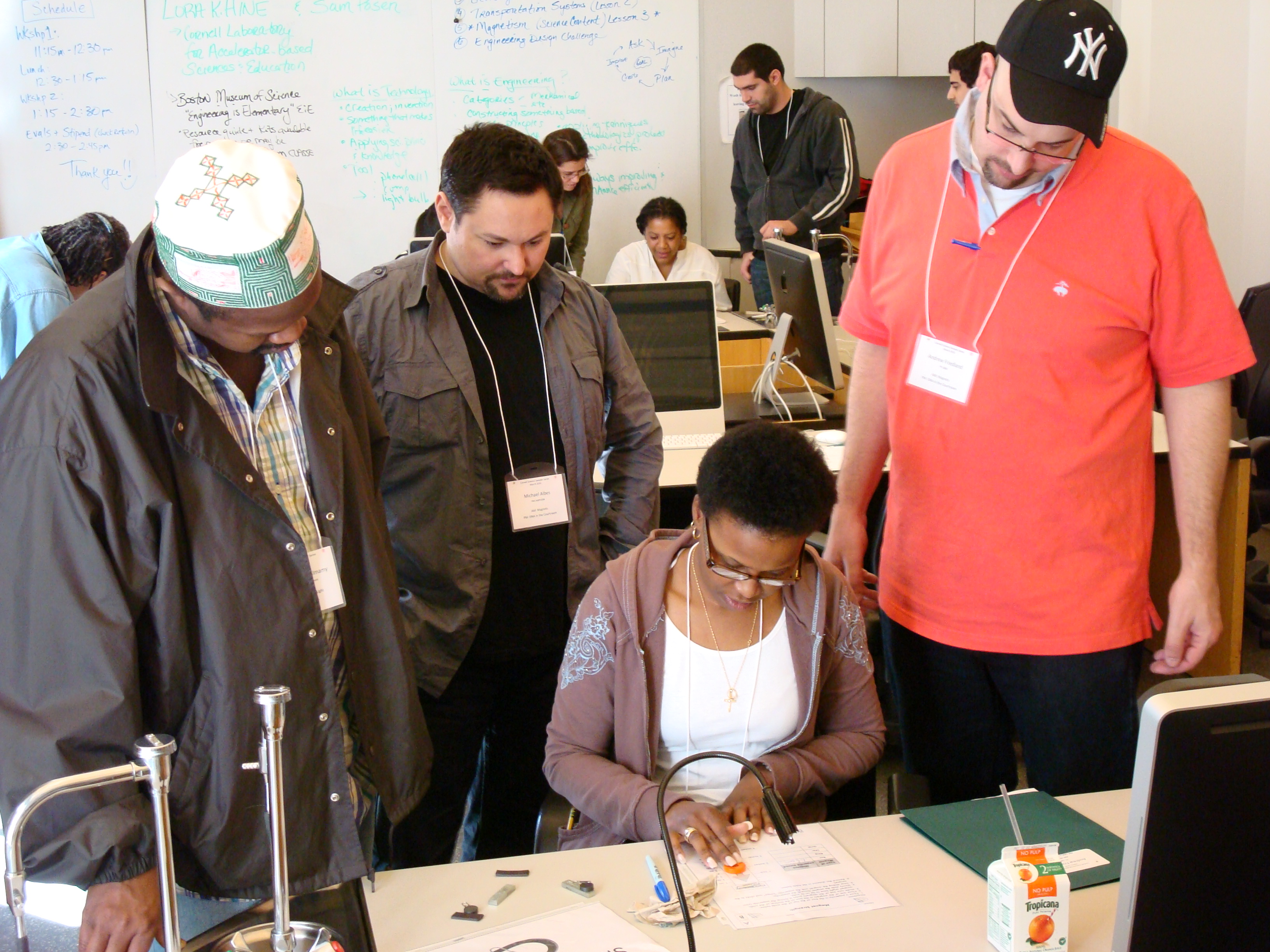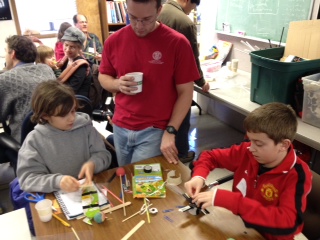X-RAY RUNS: Apply for Beamtime
2017 Nov 1 - Dec 21
2018 Feb 7 - Apr 3
2018 Proposal/BTR deadline: 12/1/17
2018 Apr 11 - Jun 4
2018 Proposal/BTR deadline: 2/1/18
__________________________________________________

Carbon, Carbon, how does your forest grow?
Carbon nanotubes (CNTs), well known for their unique combination of mechanical, thermal, and electronic properties, are already manufactured used for a large array of applications. Many additional applications are enabled by densely packed, aligned bundles of CNTs known as CNT-forests. Although such forests are routinely produced, many mysteries surround the mechanisms by which they form and, critically, what factors control and limit their properties, including their maximum length.
See complete article: http://news.chess.cornell.edu/articles/2012/Woll12212012b.html
__________________________________________________
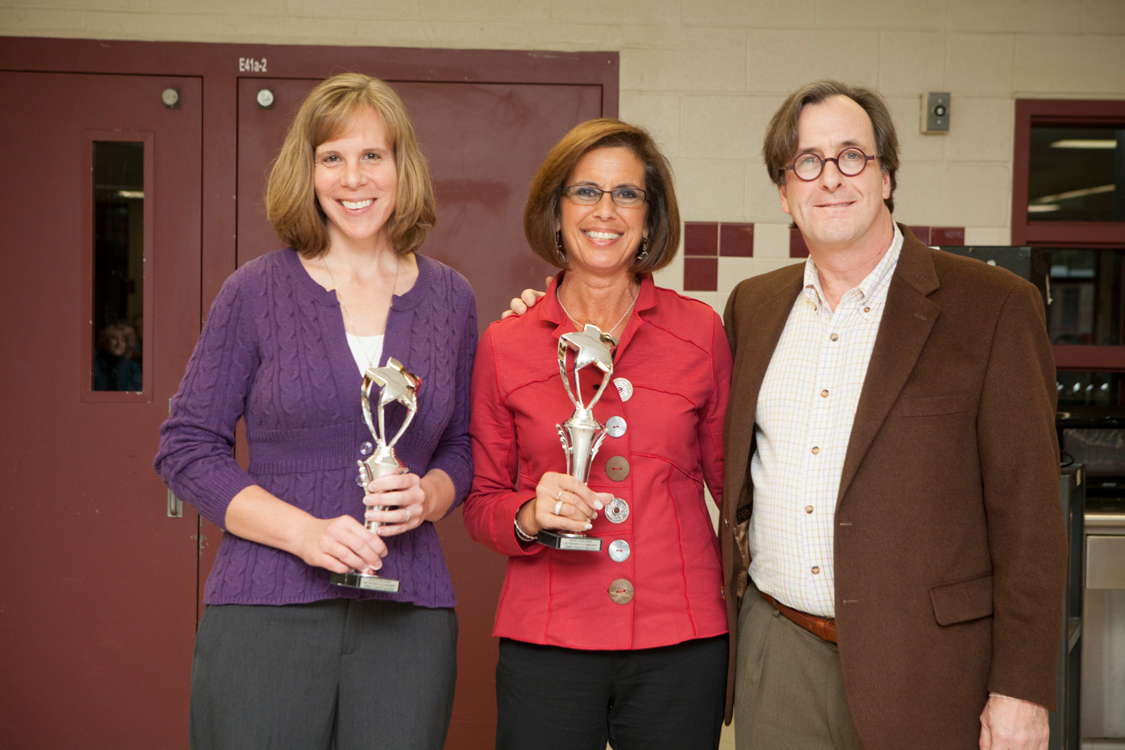
Lora Hine (CLASSE Outreach, Cornell
University),
Karen Keller (ICSD), and Tommy Bruce (VP for University
Communications)
CLASSE Outreach receives TOGO (Town Gown) Award
President David Skorton and Cornell senior leaders presented the annual Cornell Town-Gown (TOGO) Awards Dec. 8, 2012 at Ithaca High School.
Lora Hine, Director of Educational Programs at CLASSE was presented the Town Gown (TOGO) award on behalf of CLASSE and other Cornell Outreach programs for their numerous collaborations with the Ithaca City School District by Tommy Bruce, VP for University Communications.
Complete article here:
http://www.news.cornell.edu/stories/Dec12/TownGown.html or see
the (PDF)
__________________________________________________
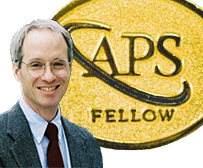
CHESS Associate Director Joel Brock elected Fellow of the American Physical Society
The Council of the American Physical Society, upon the recommendation of the Division of Materials Physics, elected CHESS Associate Director and Cornell Professor of Engineering and Applied Physics for the honor of Fellowship in the Society.
The citation for Fellowship reads: "For innovative time-resolved and in-situ synchrotron x-ray experiments on the structure, dynamics, and growth mechanisms of complex, low-dimensional systems, including liquid crystals, charge density wave systems, ion-bombarded surfaces, electrodeposition and pulsed-laser deposited complex oxides".
APS Fellowship each year is an honor reserved for less than five out of a thousand APS members. Presentation of the Fellowship certificate will be done at the APS March meeting in 2013. Congratulations Professor Brock!
Read more at http://www.aps.org/programs/honors/fellowships/index.cfm
__________________________________________________
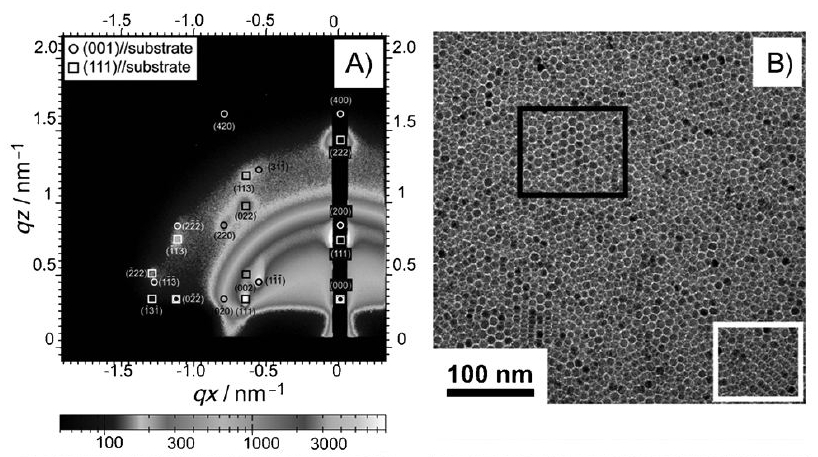
Silicon Superlattices are Finally Made
Superlattices of silicon nanocrystals are finally made. The sterically-stabilized nanocrystals self-assemble into face-centered cubic superlattices, as shown above. The work was led by Prof. Brian Korgel of the University of Texas at Austin. Diffraction data were taken at the CHESS D1 station.
Read more at http://www.chemeurope.com/en/news/140629/a-bright-future-for-silicon.html.
Reference: Yixuan Yu, Christian A. Bosoy, Colin M. Hessel, Detlef Smilgies, and Brian A. Korgel; “Silicon Nanocrystal Superlattices”, ChemPhysChem Communications. Published online on 22 Nov 2012 at: http://onlinelibrary.wiley.com/doi/10.1002/cphc.201200738/abstract, DOI: 10.1002/cphc.201200738
__________________________________________________
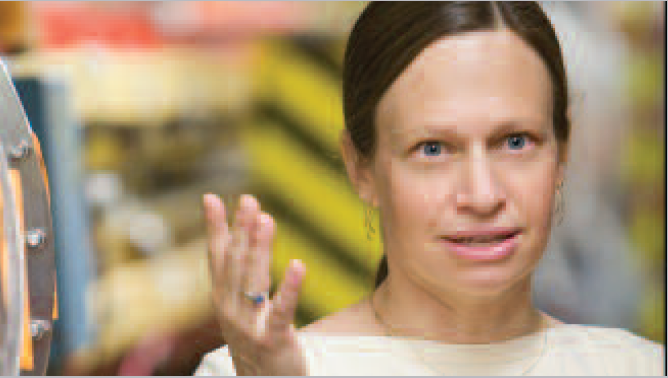
A Conversation with Ritchie Patterson: New CLASSE Director discusses research and education projects
“Connecting with Cornell,” the magazine covering news from the Cornell Office of the Vice Provost for Research, has again highlighted CLASSE in an article interviewing Ritchie Patterson on her assuming the role of Director of CLASSE in 2012. In past years, the magazine has showcased Cornell’s wide-ranging expertise in particle physics, accelerator technologies, and x-ray sciences. With this its latest and last issue, the article covers how CLASSE continues a stellar trajectory in 2012, as the center welcomes a new director, Ritchie Patterson, whose Cornell career spans undergraduate student, CHESS operator, and department of Physics faculty member and chair.
Read full "Conversation with Ritchie Patterson here: (PDF)
See the entire issue of “Connecting with Cornell” here: http://www.research.cornell.edu/VPR/CWC231-12/
Or see complete issue with article below (go to page 101):
__________________________________________________
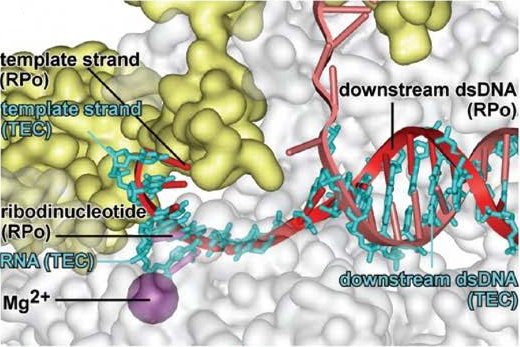
Structural Basis of Transcription Initiation
A group of Rutgers researchers has solved X-ray crystal structures of the RNA polymerase (RNAP)-promoter open complex, a key structure for understanding transcription initiation. Transcription is the copying of a gene to make a complementary RNA, which may then be translated by a ribosome to make a protein. Transcription and translation, along with DNA replication, are the three most fundamental molecular processes within cells. Before transcription the RNA polymerase, aided by initiation factors, must recognize the promoter, a special DNA sequence which marks the start of a gene.
Complete article here:
http://news.chess.cornell.edu/articles/2012/RNA11162012.html
__________________________________________________
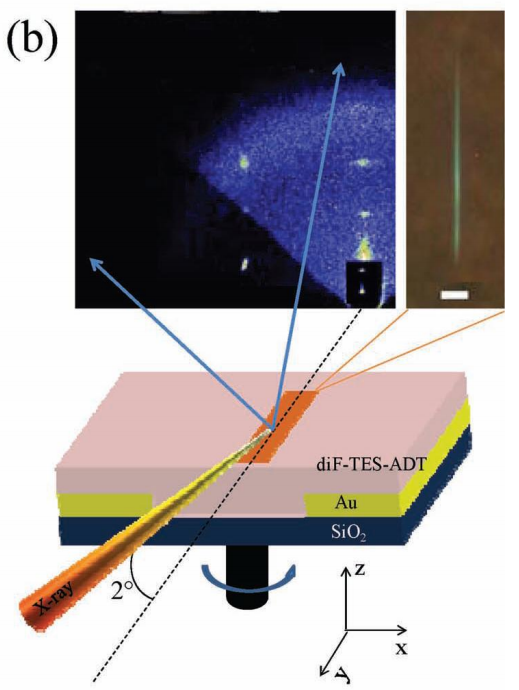
How to Design an Organic Transistor
Plastic electronics, in which an organic material replace silicon, has the promise for more cost- and energy-efficient production of mass-produced electronics by avoiding the high vacuum and high temperature processing that characterizes silicon-based devices. However, much remains to be understood about low-temperature solution processing before gadgets using organic circuitry can go into production. The research group of Aram Amassian at King Abdullah University of Science and Technology (KAUST) recently joined forces with Oana Jurchescu’s group at Wake Forest University and of D1 scientist Detlef Smilgies to study the best way to design an organic transistor.
Complete article here:
See article from Wake Forest University:
http://www.wfu.edu/academics/physics/news/20/12f-13s/jurchescu/advmater_cover.html
or from the Beacon (Kaust publication):
PDF
Also see article from Cornell Chronicle Online:
http://www.news.cornell.edu/stories/Nov12/chessOrganic.html
http://news.chess.cornell.edu/articles/2012/Organic11092012.html
__________________________________________________
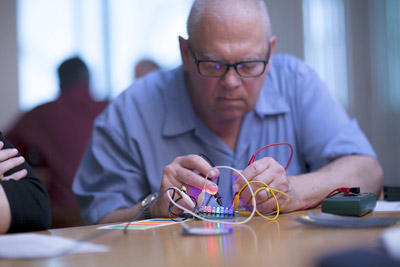
Image by: Robert Barker/University
Photography
CIPT workshop supports community of teachers with research, resources
Nearly 50 high school physics teachers from across New York state and the Northeast gathered at the Cornell Laboratory for Accelerator-based Sciences and Education Institute for Physics Teachers fall workshop, "Particle Physics and the Higgs Boson," Oct. 27. The day included tours of facilities, a lecture on the Higgs Boson particle, and two lab activities that teachers can take back to their classrooms.
Complete article
from the Cornell ChronicleOnline here:
http://www.news.cornell.edu/stories/Nov12/ciptWorkshop.html
or see the (PDF)
__________________________________________________
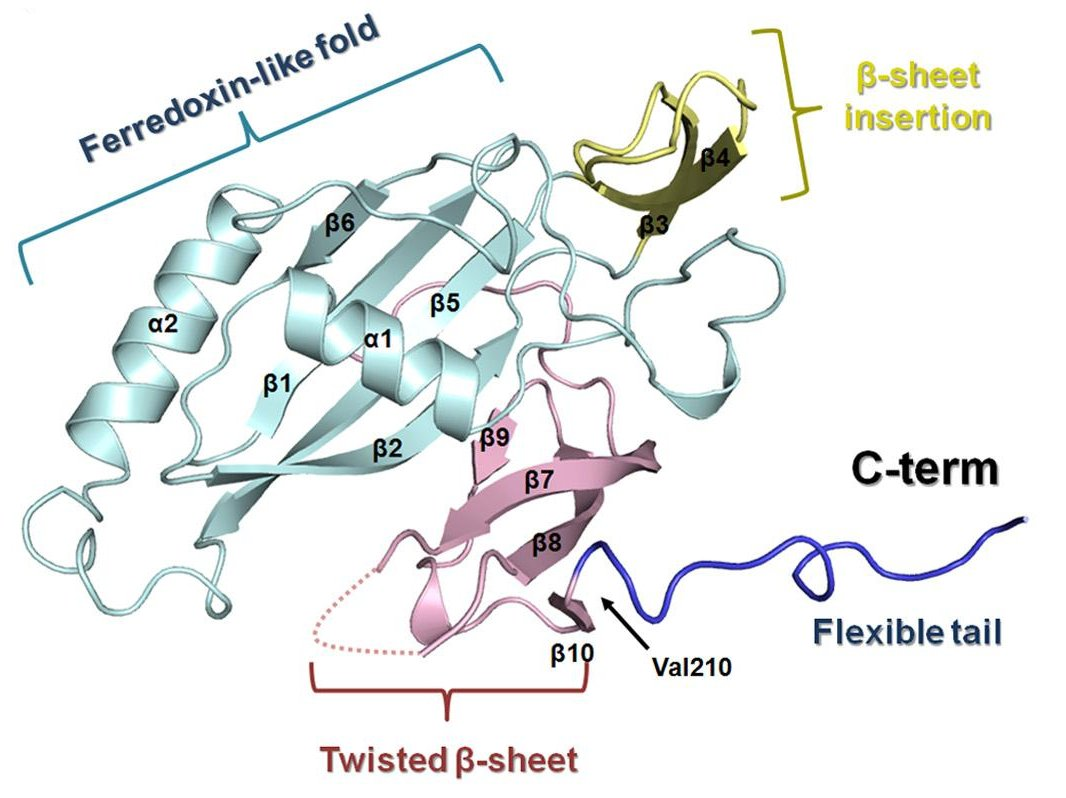
Adaptive Immune Systems of Bacteria
Bacteria are constantly bombarded by foreign genetic elements in the form of viruses, plasmids and transposons. Within the last decade it has been discovered that many prokaryotes (one-celled organisms without a nucleus) possess an adaptive immune system for fighting these invaders at the nucleic acid level with guide RNAs. This follows an earlier discovery that some eukaryotes have an analogous anti-sense RNA defense called RNAi (i for interference). It will be important to understand these bacterial defense systems since bacteriophage (viruses which infect bacteria) are used as therapy to treat bacterial infections in humans and animals and as an anti-bacterial measure in meat processing.
Complete article here:
http://news.chess.cornell.edu/articles/2012/Bacteria11012012.html
__________________________________________________

Interface-controlled Crystallization
We all have loved to play with woodblocks at some point of our career. At first, we may have put block to block to create a square array as a base, and then we started the next layer. At this point an interesting question arises: do we put the first block on top of a bottom block, do we choose a brick-wall arrangement, or maybe put it on the junction of four underlying blocks to go for a pyramid? Now, what would happen, if we tried to build a block arrangement on the nanoscale? At this length scale, manual manipulation is obviously impossible, and we will have to turn to clever methods to direct the self-assembly of nanoscale building blocks. This means in context of our favorite Kindergarten activity: let’s throw all cubes back into the box, give it a good shake, and see what we get!
Complete article here:
http://news.chess.cornell.edu/articles/2012/Nanocubes10292012.html
__________________________________________________
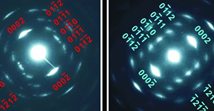
Brighter LED Displays
Collaborative work between researchers from the Chemistry Department of the University of Florida and the Cornell High Energy Synchrotron Source (CHESS) at Cornell University has resulted in novel way to make colloidal superparticles from oriented nanorods of semiconducting materials. The resultant superparticles exhibit enhanced light emission and polarization, features that are important for fabrication of LED televisions and computer screens. The nucleated superparticles can further be cast into macroscopic polarized films. Using currently available manufacturing techniques, these films promise to increase efficiency in polarized LED television and computer screen by as much as 50%.
Complete article here:
http://news.chess.cornell.edu/articles/2012/LED10232012.html
Also see article by the Cornell Chronicle online here: http://www.news.cornell.edu/stories/Oct12/wangLED.html or (pdf)
__________________________________________________
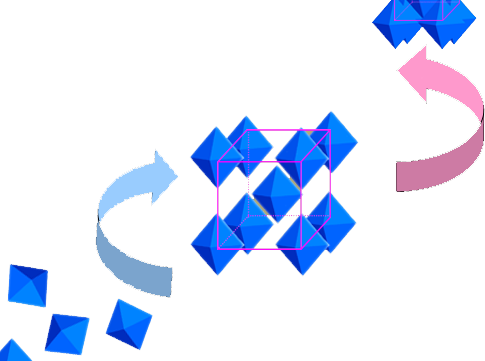
Watching Nanoscale Octahedra Crystallize
Assembly of nanoparticles into ordered superlattices opens up many potential applications such as sensors, catalysts, and novel optical materials. Nanoparticles consist of an inorganic core that can be a metal, a semiconductor or an insulator, and an organic ligand corona that makes particles soluble and prevents them from sticking together irreversibly. Another distinct feature is the shape of the core – recently spheres, rods, cubes, octahedra and many others have been synthesized. While spheres readily self-assemble into close-packed structures, recently it has been found that also non-spherical particles can form highly ordered lattices – sometimes with unusual properties!
Complete article here:
http://news.chess.cornell.edu/articles/2012/Fang10172012.html
__________________________________________________
Subversion of Host Phosphoinositides by Legionella
Legionella pneumophila is a bacterium which can be found in the stagnant water of poorly-maintained air conditioning systems and similar environments, and is linked to sporadic outbreaks of the human affliction known as Legionnaires' disease. When L. pneumophila cells are inhaled into the lungs, they are swallowed by immune cells known as macrophages. They may then secrete proteins into the macrophages which alter the vacuoles in which they are contained into a more hospitable environment for themselves..
Complete article here:
http://news.chess.cornell.edu/articles/2012/SidF10112012.html
__________________________________________________
Recovering Data from Noise
Using recently-developed theoretical techniques, members of Sol Gruner's research group have experimentally demonstrated that a collection of severely noise-limited images -- that is, images containing 2 to 3 photons each -- contains enough information to reconstruct the original object. Amazingly, the procedure works even though the object's orientation varied randomly among the images.
Complete article here:
http://news.chess.cornell.edu/articles/2012/PADman08012012.html
__________________________________________________
Faster, Better, Cheaper: Record-breaking organic electronics
A collaborative effort involving Professor Aram Amassian's group at King Abdullah University of Science and Technology (KAUST), as well as two groups at Imperial College London, and including research performed at CHESS, has produced organic thin film transistors (OTFTs) from a novel blend of polymer and small-molecule organic semiconductor materials. Devices from the blend have mobilities exceeding 5 cm2/V -- far higher than those achieved with polymers alone -- in addition channel current on/off ratios of 106.
Complete article here:
http://www.kaust.edu.sa/media/features/amassian.html or (pdf)
__________________________________________________
New Insights into anti-AIDS Drug Action
HIV reverse transcriptase (RT) is a key protein that allows the human immunodeficiency virus to multiply inside infected cells. As such, RT is a major target of drug design efforts. Because of the naturally rapid mutation of HIV, no single drug is completely effective and existing treatments often consist of cocktails of multiple drugs.
Complete article here:
http://news.chess.cornell.edu/articles/2012/Arnold06222012.html
__________________________________________________
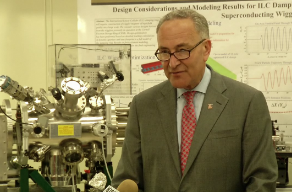
Cornell Synchrotron Gets Support From N.Y.'s Senior Senator
Sen. Charles Schumer visited Cornell on June 18th and voiced strong support for a long-term plan for continued operation of the CHESS facility. He described his discussions with the NSF and the Administration on this matter.
Complete article
from the Cornell ChronicleOnline here:
http://www.news.cornell.edu/stories/June12/schumerCHESS.html
or see the (PDF)-video
available online version
__________________________________________________
New Description Shows that Single Electrons May Not Produce Diffraction Limited X-ray Beams
A long-term goal of the synchrotron radiation field has been to develop “perfect” hard x-ray synchrotron sources that would be capable of producing x-ray beams having full coherence and being diffraction limited. A fully coherent and diffraction limited beam would enable many new x-ray applications such as three-dimensional x-ray holography and nanoprobe microscopies, to name a few. Synchrotron x-ray beams are produced accelerating electrons to nearly the speed of light and passing them through arrays of magnetic devices called undulators. In order to increase the coherence and approach the diffraction limit it is necessary for the electrons in the beam to have as nearly the same energy and trajectory as possible.
Complete article here:
http://news.chess.cornell.edu/articles/2012/Wigner06122012.html
__________________________________________________
Infrared LEDs can be made cheaper, compatible with silicon
Light-emitting diodes at infrared wavelengths are the magic behind such things as night vision and optical communications, including the streaming data that comes through Netflix. Cornell researchers have advanced the process of making such LEDs cheaper and easier to fabricate, which could lead to ultra-thin LEDs painted onto silicon to replace computer wiring with light waves.
Complete article from the Cornell ChronicleOnline here: http://www.news.cornell.edu/stories/May12/qdLEDs.html
or see the (PDF)
__________________________________________________
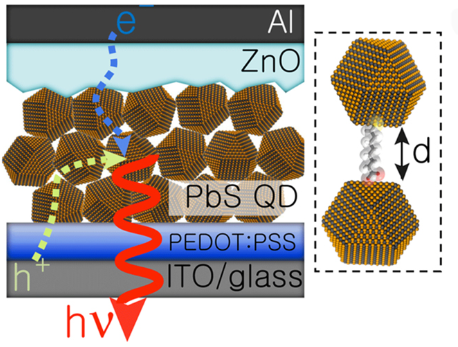
Bright Light via Molecular Control
The availability of colloidal quantum dots (QDs) with well-defined size and shape has created intriguing opportunities for scientists and engineers to create materials with properties by design. Colloidal semiconductor QDs have been proposed as building blocks for the development of solution-processed optoelectronic devices, including next-generation photovoltaics, photodetectors and light emitting diodes (LEDs). Bringing this much-heralded technological potential to fruition depends on nanoscale charge-carrier dynamics, which are poorly-understood and therefore poorly-controlled. Consequently, the performance of prototype devices has, so far, has been limited.
Complete article here:
http://news.chess.cornell.edu/articles/2012/Hanrath05112012.html
__________________________________________________
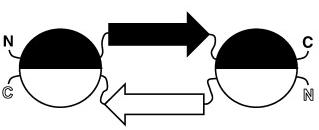
Using Mutations to Control Protein Domain Swapping
Many biological processes require the formation of protein complexes containing multiple copies of one or more types of polypeptide chain. It is critical that the protein chains involved correctly recognize each other and assemble into the proper sequence. One mechanism providing high specificity in protein-protein recognition and assembly is domain-swapping, in which structural elements such as β-sheets, which usually occur within a single protein domain, contain chain segments from two different protein molecules.
Complete article here:
http://news.chess.cornell.edu/articles/2012/Ha05102012.html
__________________________________________________
Cornell Makes Physics Fun at D.C. Science Expo
Communicating with light and building a photon factory were among activities led by Cornell scientists, staff and students meant to engage and inspire the public at the second USA Science and Engineering Festival in Washington, D.C., April 28-29.
Complete article from the Cornell ChronicleOnline here: http://www.news.cornell.edu/stories/May12/dcExpo.html
or see the (PDF)
__________________________________________________
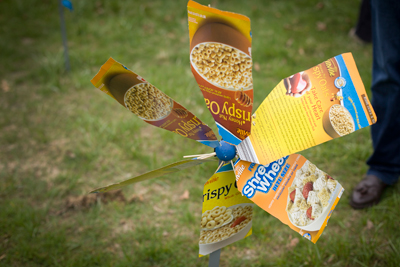
Wind Turbine Challengers 'catch the breeze'
Homemade wind turbines dotted the Ithaca Children's Garden at Cass Park April 22 for the final judging of the "Catch the Breeze Wind Turbine Challenge" competition.
Since the competition's March 10 kickoff, participants have designed and built wind turbines using inexpensive materials while applying basic physics principles. In the process, they learned how wind energy is converted into electrical energy.
Complete article from the Cornell ChronicleOnline here: http://www.news.cornell.edu/stories/April12/windTurbine.html
or see the (PDF)
__________________________________________________
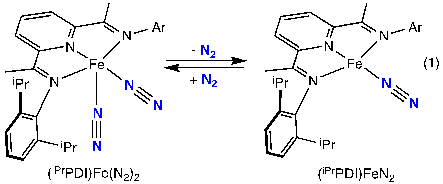
X-ray Absorption and Emission Spectroscopy - Determining effects of N2 coordination on the electronic structure of bis(imino)pyridine iron (PDI) pre-catalysts
The largest scale application of homogeneous catalysis (by dollar amount of product sold) is hydrosilylation, a process used to manufacture chemicals used in consumer products from iPhones to beer. On the industrial scale, the catalyst used is platinum-based, but the reaction can now be done using a cheaper, iron-based system in which no disadvantageous side products are formed.
Complete article here:
http://news.chess.cornell.edu/articles/2012/Stieber04242012.html
__________________________________________________
A scanning electron microscope image of the side of a stack of nanosheets. The inset is an optical microscope image of a single exfoliated nanosheet, to show it is optically transparent.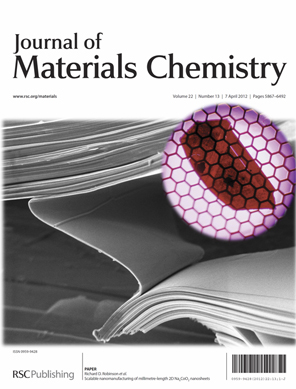
Nontoxic Nanosheets Could Turn Waste Heat into Power
Science writer Anne Ju writes a Cornell Chronicle article highlighting the work of CHESS user Richard Robinson, whose group uses CHESS to characterize nanosheets. She writes: “Cornell materials scientists have developed an inexpensive, environmentally friendly way of synthesizing oxide crystal sheets, just nanometers thick, which have useful properties for electronics and alternative energy applications. The work, led by Richard Robinson, assistant professor of materials science and engineering, is featured on the cover of the April 7 Journal of Materials Chemistry (Vol. 22, No. 13)".
The paper discusses, among other things, how x-ray synchrotron studies reveal how the 2D crystals stack in a turbostratic arrangement with rotational misalignment along the stacking axis. They point out that graphene has been well studied, but that other materials open new grounds for exploration.
Complete article from the Cornell ChronicleOnline here: http://www.news.cornell.edu/stories/April12/robinsonNaCo.html
or see the (PDF)
__________________________________________________
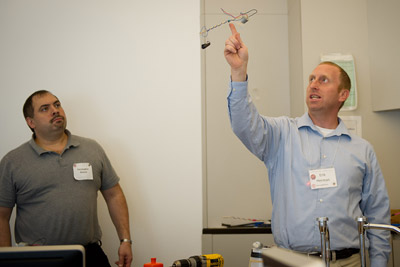
NYC teachers learn hands-on activities to inspire students
50 teachers attend the March 24 session at Weill Cornell Medical College, which featured seven workshops and a keynote address from Larry Bonassar, Cornell associate professor of Biomedical and Mechanical and Aerospace Engineering, on cartilage tissue engineering. The series, sponsored by the Cornell Center for Materials Research (CCMR), has been offered to New York teachers twice a year since 2007 and complements state education standards. It is a collaboration with the Cornell Institute for Biology Teachers, Cornell Laboratory for Accelerator-based Sciences and Education, Boyce Thompson Institute for Plant Research, Center for Nanoscale Systems and Weill Cornell.
Complete article from the Cornell ChronicleOnline here: http://www.news.cornell.edu/stories/March12/NYCSciSampler.html
or see the (PDF)
__________________________________________________
Turbine Challenge
Over 120 people gathered at the eXploration station to challenge themselves to design, construct, and then optimize their own wind turbine for the kickoff of our Catch the Breeze Wind Turbine Challenge on Saturday, March 10, 2012.
Complete article from the TompkinsWeekly here: (PDF) See page 5.
__________________________________________________

Putting a New Spin on KCuF3
Scientists who study condensed matter physics (CMP) try to explain macroscopic electrical, magnetic & thermal properties of solids using models of atomic scale interactions of the constituent atoms and electrons. One of our great theoretical successes, the band structure of semiconductors, has literally transformed our world with the invention and evolutionary applications of the common transistor. To this day new observations of physical phenomena continue to challenge condensed matter physicists and have led to much deeper understanding of materials that lead, in turn, to a host of new technologies and products that we all get to enjoy.
Complete article here:
http://news.chess.cornell.edu/articles/2012/NewSpin03292012.html
__________________________________________________
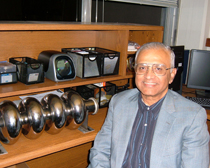
Hasan Padamsee receives IEEE Particle Accelerator Science and Technology Award
Hasan Padamsee has been awarded this year's IEEE Particle Accelerator Science and Technology Award For contributions to the science and technology of RF superconductivity.
The prize recognizes individuals who have made outstanding contributions to the development of particle accelerator science and technology. Hasan joined Cornell's SRF group in 1973 and was its head from 1987 to 2009, during a period when gradients pushed the theoretical limit, and new techniques in polishing and cavity repair led to dramatically improved performance and reliability, successes which are to no small measure attributable to Hasan's contributions. Hasan also oversaw the development and implementation of the SRF cavities in CESR, using a design that has now been transferred to two industrial vendors and is used at seven other accelerators around the world. Additionally, Hasan authored the two defining text books on SRF accelerating structures.
Text and image from the SRF group at Cornell site:
http://www.lepp.cornell.edu/Research/AP/SRF/WebHome.html
__________________________________________________
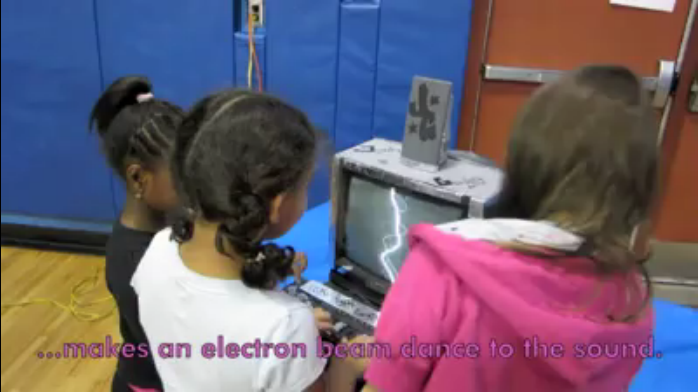
Junk Genies of Science
Every week, eight to 12 middle school students from the Greater Ithaca Activities Center (GIAC) afterschool program build complex science exhibits in the eXploration station behind Wilson Lab. Dubbed the "Junk Genies of Science", they create models that exhibit principles of physics.
Full article here:
http://news.chess.cornell.edu/articles/2012/JunkGenie03062012.html
__________________________________________________
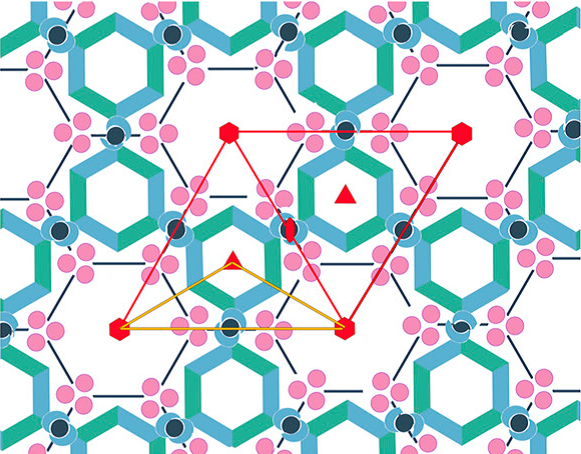
Honeycomb Structure Responsible for Bacteria's Extraordinary Sense
Researchers in the lab of Brian Crane, professor of chemistry and chemical biology, with collaborators in the lab of Grant Jensen at the California Institute of Technology, have mapped out the honeycomb-like hexagonal arrangement of these receptor complexes in unprecedented detail.
Full article here:
http://news.chess.cornell.edu/articles/2012/chemarrays.html
__________________________________________________
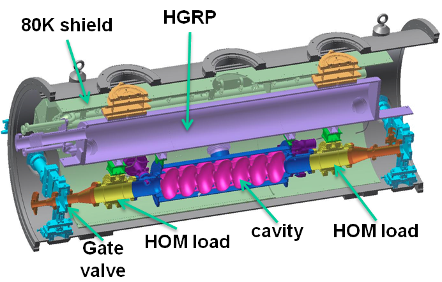
Cornell ERL Prototype Successes Grow
The goal of the Energy Recovery Linac (ERL) project at Cornell is to create a new type of continuous-duty x-ray source, and to do so requires making ultra-low emittance electron bunches and accelerating and recovering their energy in a superconducting linear accelerator. Three of the biggest R&D challenges are to prove it possible to build an electron injector with (1) sufficient current, (2) sufficiently small emittances, and a superconducting linac with (3) sufficiently small energy consumption.
Full article here: http://news.chess.cornell.edu/articles/2012/ERLgoals02152012.html
__________________________________________________
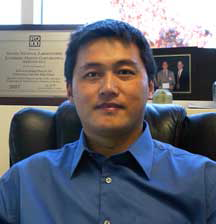
CHESS User Named the 2012 Asian American Engineer of the Year
CHESS is proud to note that CHESS user, Hongyou Fan, working at Sandia National Laboratories, Albuquerque, New Mexico has been named the Asian American Engineer of the Year (AAEOY) 2012 by the Chinese Institute of Engineers USA (CIE/USA). Hongyou is well known for his innovative work in the field of nanomaterials and self-assembly.
Full article here: http://news.chess.cornell.edu/articles/2012/HFan02072012.html
__________________________________________________
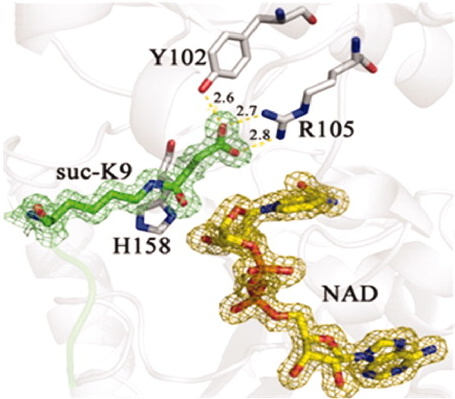
Sirtuins, Post-translational Modifications, and the Impact of Crystal Structures
For some proteins, more is needed after their translation from DNA before they are functional. Small molecules are attached to certain amino acids in the protein in a process called post-translational modification. If the attachments are later removed, the behavior of the protein changes. The family of proteins called "sirtuins" is responsible for such removals in a number of biological systems. The sirtuins have attracted a great deal of interest from a broad biological community because of their suggested roles in the regulation of gene transcription and chromatin structure, as well as DNA repair and genome stability, cell metabolism, and perhaps most importantly, their potential connections to disease states (e.g. cancer) and aging.
Full article here: http://news.chess.cornell.edu/articles/2012/Sirtuins01312012.html
__________________________________________________
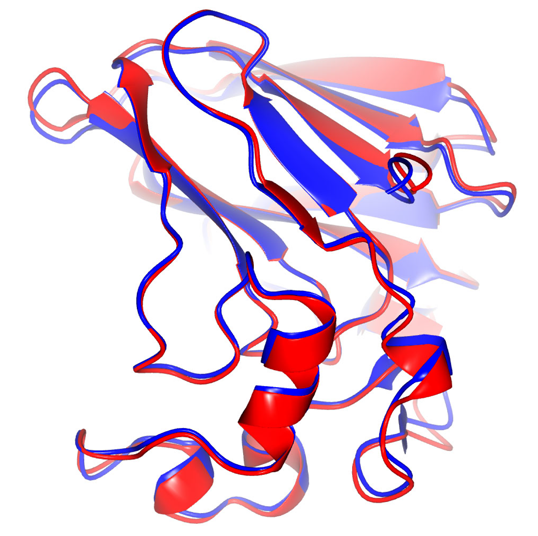
Protein Shows Conformational Fluctuations at Cryogenic Temperatures
Proteins must fluctuate in order to perform cellular functions, such as enzymatic catalysis, protein-protein interactions, and interactions with DNA and RNA. When proteins are cooled the fluctuations dampen and eventually stop, typically at 200 - 240 K. This is called a protein dynamical transition. Proteins below the transition temperature show no appreciable biological function. Above the transition temperature flexibility is restored and the protein becomes increasingly biologically active.
Full article here: http://news.chess.cornell.edu/articles/2012/ProCryo01112012.html
__________________________________________________
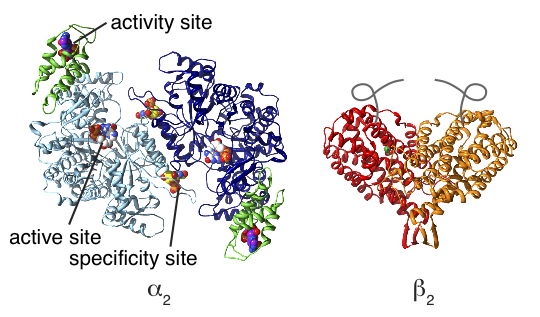
The Ring of Life: X-ray Scattering Reveals Secrets Leading to DNA Synthesis
Synthesis of DNA is an essential foundation for all life on Earth. In all organisms, the precursors for DNA (deoxyribonucleotides) are made from the precursors for RNA (ribonucleotides) using an enzyme called ribonucleotide reductase (RNR). RNRs are classified by the metal-containing cofactor that is used to generate a radical essential for catalysis. Class Ia RNRs (used by all eukaryotes and many aerobic bacteria) are unusual in that the nucleotide-binding sites and the radical-generating metallocofactor are housed in separate homodimeric proteins.
Full article here: http://news.chess.cornell.edu/articles/2012/ROL01062012.html

